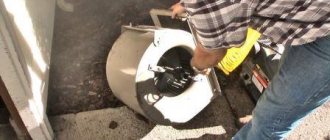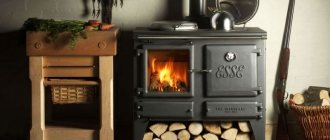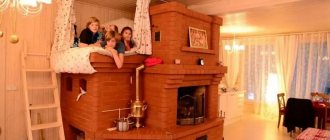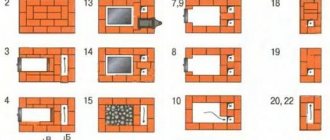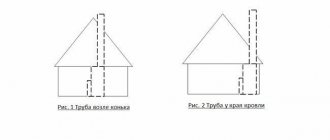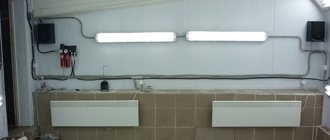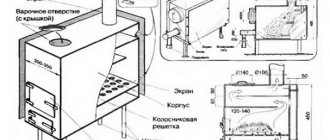How does a garage cool down?
What is the square-cube ratio? Heating engineers know this parameter firsthand. The thing is that the smaller the building, the greater the ratio of the area of its limiting structures to the internal volume of the room. This means that heating it will require more thermal energy.
So that you understand what we are talking about, let’s compare two objects: a house 10x12 m with a height of 5 m, a garage 7x4 m with a height of 2.25 m. The volume of the house is 10x12x5 = 600 m³. The area of the structural elements, which are four walls, a floor and a ceiling, through which heat loss occurs, is 460 m² (it’s easy to calculate, everything is at the school curriculum level). Now the volume of the garage is 63 m³ and the area of its boundary structures is 105.5 m².
The optimal temperature in the garage is no more than +16C Source ko.decorexpro.com
Now it is necessary to compare the ratio of the total area to the volume of each object. It turns out at the house: 460/600=0.77, at the garage: 105.5/63=1.67. That is, the comparison shows that the garage’s heat loss area is almost twice as large as that of the house. So it turns out that the stove that will have to be used in the garage must be more powerful.
Of course, you can take into account that the garage temperature may be lower than in the house. For example, optimally it will be no more than +16C. But even in this case, the heating element will still be more powerful than the one used in the house.
Main types
Garage wood-burning stoves differ in the type of their design. The main options are:
- Rectangular metal stoves. They come in horizontal and vertical types. Such units are simple to manufacture, cheap, and easy to maintain.
- A stove made from gas cylinders or old barrels. They also exist in two versions – horizontal and vertical. Unlike the previous type, they are most often made by hand, using welding and gas cutting. Their disadvantage is the lack of a stable cooking surface, because... they are round in cross section. However, there are factory analogues in which such a surface is provided.
- Long-burning wood-burning garage stove. The main difference between such a stove and a potbelly stove is that the wood in it does not burn, but slowly smolders. This is achieved using a special gate and vent system that regulate the access of the air mixture to the fuel.
- Brick stove for the garage. Well suited for those garages that are built of brick. Otherwise, heat loss will be very significant, and the profitability of such a device will be low. Its advantages are fire safety and dimensions, which the garage owner can customize based on his needs and preferences.
- Buleryan. The most expensive type of iron stove for a garage. It has many advantages, such as: high efficiency, the ability to operate on any solid fuel, and a long operating time. This good wood-burning stove for the garage is deservedly popular in our country.
Rules for heating a garage
So, having dealt with heat loss, let’s move on to the question of how to properly heat a garage. Firstly, it should be noted that a more powerful stove means higher fuel consumption. This means that it is necessary to purchase an economical heating unit that has a high efficiency.
Secondly, the stove must heat the garage quickly. And if this concerns a private garage, then it should cool down quickly. This is due to fire safety requirements. Wood-burning garage stoves typically fall into this category. They quickly heat up and heat the room (15-20 minutes), and also cool down quickly. But due to low fire safety, such units are rarely used.
A wood stove is the fastest way to heat a room Source drive2.ru
However, it should be noted that wood-burning stoves are the most efficient of all those offered. Therefore, manufacturers try to maximize their safe operation. But you don't need a large, powerful furnace to heat your garage. The main task of the heating device is to heat quickly. And this can be done using low-power models. Vedas main requirement is the rapid appearance of thermal energy that heats the air. And the last one rushes up to the ceiling.
But on its way it is sure to encounter a layer of cold air, which is denser than warm air. This means that heat will begin to spread along the bottom, mainly near the floor, gradually heating the space as a whole. At this heating rate, warm air will never reach the ceiling; it will spread wider. In this case, the upper part of the garage and its walls will remain cold, because the convection of warm air will spread like a mushroom, that is, to the ceiling without touching it, and then along the walls to the floor. In this case, the warm air will not touch the surfaces of the walls either. And there is no contact with cold surfaces, and there is no heat loss through them.
Low-power stoves work well in insulated garages Source drive2.ru
See also: Catalog of garage projects presented at the Low-Rise Country exhibition
If you use an ordinary stove for the garage, which is used in homes, then all the physical laws described above will not work. This mainly applies to garages where the thermal insulation qualities of the materials used have not been taken into account. But keep in mind that non-thermally insulated garages absorb thermal radiation instantly. So this heating option, and any other, can be immediately discarded as ineffective.
Therefore, before deciding on a garage stove, it is necessary to think through and carry out thermal insulation measures. It is important to choose the right insulation and finishing. Optimally, if space allows, thermal insulation is carried out from the outside. The simplest option is brick cladding.
Insulated garage with bricks from the outside Source 100realt.ru
See also: Catalog of companies that specialize in installation services for fireplaces and stoves
Suitable stove options for heating garages
There are several options for garage stoves that can be considered suitable to one degree or another.
Buleryan
Figure 4. Buleryan stove
Looking ahead, we can say that this is the best solution for a small autonomous room. Canadian engineers developed this stove for other purposes, but it just so happens that it is almost ideal for garage heating. Buller is relatively inexpensive, heats well and is not voracious.
In fact, this is a descendant of the well-known potbelly stove. In the context of heating a garage, it would be more correct to call Buleryan a convection unit. On sale you can find stoves with a power of 2 to 200 kW - there is a solution for a room of any size. The efficiency of such structures reaches 80-90%.
Any buller will work as a stove for a private garage. But the best option would be a tent “half-buleryan”. It is distinguished by nozzles that are not directed diagonally, as in other designs, but straight upward. This ensures more efficient formation of a thermal cap - an air mushroom-shaped thermal flow.
Figure 5. Half buller
Buleryans, unfortunately, have a drawback. Since they were designed for lumberjacks, they can be used to heat a garage using wood. But only. So far, equipment of this type has not yet been invented that would work on peat or coal. And at the same time it would give a comparable effect.
But the advantages of the units outweigh the disadvantages:
- noticeable heat transfer – already 5 minutes after start; or even earlier;
- one load of firewood is enough for up to 8 hours of heating;
- the ability to use even damp logs as fuel; at the same time, the efficiency decreases slightly.
If the car owner does not have a strong desire to make heating equipment for the garage with his own hands, Buleryan is suitable like no other unit. You can make a buller yourself, but to do this you need to have a number of special machines.
Figure 6. Drawing of Buleryan
How to outwit Buleryan?
A Canadian wood stove can be converted into equipment that does not require wood. But only on the condition that the buller will be used for short-term heating. The role of logs will be played by fireclay bricks. The usual one is not suitable - it does not have sufficient thermal conductivity.
Recommendation! Do not use red brick - you will not achieve the desired effect with it
The scheme is like this:
- bricks are used to make a brick no larger than a pack of cigarettes;
- the firewood is loaded into the firebox so that there is space between the fireclay for the circulation of air flows;
- heat the stove heat accumulator using a burner; it takes about five minutes to heat a brick red-hot;
- close the firebox door, chimney view and power regulator.
These manipulations are enough to warm up the room relatively well and maintain heat transfer for 1-3 hours.
Since it is not easy to make buleryan yourself, many “homemade” people prefer other options. More about them later.
Brick stove
Figure 7. Brick garage stove
Homemade brick stoves with a base size of 2x2.5 bricks can handle heating a typical garage. But it’s difficult to recommend them to those who drop into the “parking lot” occasionally and for a short time. The oven takes too long to warm up. Yes, it gives off heat even longer – for several hours. But spending an hour and a half on kindling and then working for 30 minutes is completely irrational.
Another disadvantage of the brick version is the impossibility of creating a thermal cap. The thermal flow that the stove creates is characterized by low intensity, insufficient to form a thermal insulating air layer.
Such structures are made from fireclay bricks, which are more heat resistant than regular red bricks. Heat-resistant clay is used as a binder, to which fireclay powder is added.
A garage structure of this type consists of a maximum of 10 rows. The firebox is made at level 2-4. The presence of a chimney is a prerequisite.
Waste liquid fuel stove
Figure 8. Stove being used up
There will be no problems with fuel - almost any car owner will have it. As a last resort, you can easily purchase it at any car service point - the cost of fuel is very modest.
The design of a typical unit involves two sections. The sections are connected by a perforated pipe. Oil burns in the lower section. This creates a small amount of heat and flammable gas. The latter goes through the pipe to another department. Thanks to perforation, a certain amount of air enters the pipe, which is mixed with flammable gas. This mixture already provides enough heat to heat the garage.
The bottom compartment is usually made of thin metal sheet. The shape does not play a special role. In order to be able to regulate the air flow, a special damper is made here.
The perforated pipe and the upper section are made of thick metal. Thin walls will not withstand high temperatures for long. The pipe with holes must also be strong because otherwise it simply cannot cope with the considerable mass of the stove in a small garage.
The chimney must be made on top of the second compartment. A side smoke exhaust duct cannot be made. Almost any mining material that is not characterized by simple high-speed ignition is suitable as fuel.
Such a stove requires a very serious attitude to safety precautions. A perforated pipe is a beating flame. Therefore, the structure must be kept away from flammable substances. If you spill gasoline near such a “hearth”, you can get a fire. For this reason, no firefighter will give official approval to heat a garage with such equipment.
Important! Responsibility for the use of such a stove rests entirely with the garage owner
Potbelly stove
Figure 9. Classic potbelly stove
The most popular and simplest version of a homemade efficient stove is a potbelly stove. You can make it right in the garage from scrap materials. Anything that has a suitable shape and strength characteristics will do. It is desirable that the metal be at least 5 mm thick. The cylinder must have a diameter of 30 cm.
A traditional stove includes:
- frame;
- ash pan;
- grate;
- firebox door;
- ash door;
- chimney (vertical or horizontal).
Scheme for making a simple potbelly stove:
- a fuel chamber is made from a suitable blank;
- a grate is installed at the bottom, and an ash pan under it; for the latter, you can use thinner sheet metal;
- a chimney is made on top or on the side; minimum cross-section is 10-12 cm, 2-3 mm wall thickness is allowed;
- supports are made from the corners.
Recommendation! To enhance the thermal effect and speed up heating of the garage, small wing plates can be welded to the sides of the potbelly stove.
The illustration shows a diagram of a simple predecessor of the Buleryan. The heat transfer of the structure is increased thanks to the use of an afterburner with a duplicated pass. One fuel load is enough for 3-4 hours. The power can be adjusted to a small extent using the door.
Figure 10. Diagram of one of the potbelly stove options
Brick kilns
It should be noted that stoves made of brick are not the best option for heating a garage space. There are several reasons for this:
- The thermal output of brickwork is 0.5 kW per 1 m² of its own plane. That is, to heat a standard-sized garage, you will need a stove that will occupy half of its area .
- For a brick structure , in which clay is used as a masonry mortar, a special microclimate with slight differences in humidity and temperature. The same cannot be said about the garage. Ved clay is a hygroscopic . It quickly absorbs moisture , cracking and delaminating.
- Convection in ovens of this type is minimal . That is, there is no need to talk about quickly heating the garage . It usually takes up to 2 hours , depending on the size of the garage space.
Small-sized brick kiln Source yastroyu.ru
But it should be noted that brick kilns are installed in garages.
Especially if the garage is used as a workshop.
The best heating boilers
If you decide to choose a high-quality boiler for your garage, you should study the manufacturers’ proposals and understand which models are more popular than others. Then you can be confident in the quality of the chosen model. How to choose which criteria to take into account?
Criteria for optimal selection of a heating system:
- price;
- productivity;
- safety;
- installation features.
Heating the garage using a boiler.
Based on these criteria, we will describe the main brands of electric boilers for the garage, which are in high demand in the domestic market and are worth the consumer’s attention:
- Baxi. An Italian brand known to customers all over the world, but it is most popular in European countries. Baxi models are distinguished by convenient adjustment, high efficiency, can operate in autonomous mode, and are capable of self-diagnosis. Baxi boilers are equipped with energy-efficient pumps that provide high efficiency. There are models that can be installed outdoors, but they are not cheap.
- Vaillant. The brand produces boilers with high performance and reliability thanks to the improved design of burners, the use of circulation pumps, and the creation of a casing made of high-quality steel alloys. Vaillant do not overheat and do not jam. But its large dimensions make it possible to place such a boiler only in a large garage.
- Protherm is a manufacturer that produces high-quality boilers of various capacities. Small-sized options are quiet, have an interesting design, and are often installed in motorhomes.
- It is also worth noting the products of the Ferroli and Bosch brands, which have also earned recognition from a large number of car owners.
On a note! An expensive boiler is not always associated with the word “good”. But often the best boiler models are still manufactured by well-known companies and are not cheap.
Choosing a garage oven
So, wood stoves are not suitable. Today, manufacturers offer liquid fuel units that run on diesel fuel and various oils (their waste). It should be noted that this is one of the optimal types of solutions for heating a garage in winter. What do manufacturers offer?
- Long burning stoves . The essence of the device and the principle of operation of the device is that the burned fuel not only burns one hundred percent, but also pyrolysis gases generated due to the combustion of the fuel itself burn. In this case, combustion heats diesel fuel or technical oil , which reduces energy losses to bring them to the required state. That is, it turns out that the long-burning furnace is divided into two parts : in one the fuel burns , in the second (upper) pyrolysis gases . Hence the double power . But such stoves are very economical : 1.5-2.0 liters of waste to produce 8-10 kW of thermal energy.
Long-burning stove model “Cinderella” Source housechief.ru
- A heat gun running on diesel fuel . Such heating devices are available in a wide range today. But this unit, even the most low-power one, has too much fuel consumption . It's all about the design of the nozzle through which diesel fuel . It is not possible to make a strong constraint on this element. Because a small hole in the nozzle will not provide a stable supply of fuel, due to which the unit itself will not work efficiently. It is better to use heat guns to heat large garages or warehouses.
Diesel fuel heat gun Source sydvesta.dk
- Infrared stoves using diesel fuel . Experts believe that this is the best option for heating small . The design of the stove is based on the so-called drip-evaporation burner , which operates on any liquid fuel and oils. Plus, a fan , which replenishes the exhaust gases emanating from the fuel combustion zone with oxygen. The result is a flammable mixture , which also burns, releasing a large amount of heat . This model is somewhat reminiscent of the first one (long-burning stove), but its efficiency is 100% .
Infrared stoves using diesel fuel Source drive2.ru
How to make a DG oven?
Step 1. To make such a stove, you can take an ordinary 250 liter barrel, which can often be seen in garden plots. This is a thick-walled structure that is perfect for creating a stove. The top part of such a stove needs to be cut off, but not thrown away.
The top of the barrel has been cut off
Step 2. From the top you will need to make a kind of lid, which will be called a “pancake” for air supply. It needs to be adjusted to the parameters of the barrel so that when it is installed in place, the distance from its edge to the walls of the barrel is about 2 cm around the entire circumference. The neck of the lid must be welded, and a hole must be made in the middle to which the air supply pipe will be attached. It is also recommended to weld 4 channels to the lid.
“Pancake” for air supply
Another photo of the item
Step 3. You need to cut a hole in the top of the barrel to install the chimney. In this case, a pipe with a diameter of 14 cm will be used as the latter.
Hole for chimney installation
Step 4. You also need to make a lid for the oven. It can be made from sheet iron by welding to it on the bottom side a sealing ring suitable in diameter to the barrel. The thickness of the sheet iron is 4 mm. In the middle of the lid there is a hole for the air duct from the “pancake”.
Oven cover
In the middle of the lid there is a hole for the air duct from the “pancake”
Step 5. On the bottom side of the barrel-stove you need to make simple legs for its installation. They should be, like everything else, made of metal.
Making legs for the stove
Legs must be metal
Step 6. Next you need to make a chimney (the stove is already installed in the desired location). He will be a national team. First, a clamp is made that will allow you to attach the chimney to the stove.
A clamp that will allow you to attach the chimney to the stove
Step 7. Now you need to make guides in the chimney itself. They will allow you to easily assemble the pipe and furnace into a single unit.
Guides in the chimney
Step 8. The pipe and barrel need to be joined together and be sure to line the joints with asbestos fabric. A clamp is placed on top of the fabric and tightened.
Asbestos fabric
Tightening the clamp over the fabric
Finished joint between pipe and barrel
Step 9: The oven can now be tested. You can put firewood and sawdust in it.
The stove is loaded with fuel
Step 10. Then you need to pour the fuel over the fuel, then close the lid. “Damn” hasn’t been set yet. When the wood gets hot, you need to remove the lid and install the pancake. Such a stove warms up fully in about 10 minutes and will burn for a very long time. However, the duration of combustion of the unit will largely depend on the quality of the firewood.
Photo of the finished stove for the garage
Prices for popular brands of portable welding machines
Portable welding machine
Video - How to make bubafonya
If desired, such a design can always be modified, although even in this state it will properly perform its functions. Thus, efficiency can be increased if the surface for heat transfer is increased. To do this, it is enough to weld metal plates on the sides of the barrel. You can also make a grate with an ash pan. From sheet metal you need to cut a circle the size of the oven diameter, drill holes in it with a diameter of about 6-8 cm and install it at the bottom. In this case, the ash will pour down through the holes, where the ash pan is equipped. They say that this will make the wood burn faster - this is important to keep in mind. So it’s worth taking care of maximum sealing of the ash pan.

